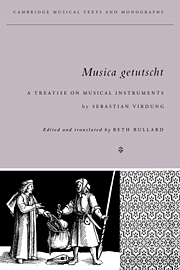Preface
Published online by Cambridge University Press: 14 August 2009
Summary
The scholarly and intellectual resources of many people and institutions helped to make possible this translation and study of Sebastian Virdung's Musica getutscht. I am indebted to librarians, especially Dr. John Roberts, as well as to keepers and curators of the myriad of rare books I consulted at libraries in France, Germany, Great Britain, Switzerland, and the United States. Also invaluable to me in this project were those who offered linguistic counsel, especially Amy Baehr, Hendrik Boswijk, the late Dr. Rudolf Hirsch of the University of Pennsylvania, and my colleagues at Dickinson College: Professors Beverley Eddy, Ingeline Nielsen, Dieter Rollfinke, and Robert Sider. I also acknowledge the input of David Robertson, former Director of the Trout Gallery at Dickinson College and specialist in German woodcuts of the Renaissance. To Howard Brown I extend thanks for his suggestions and for his challenges. I express my special gratitude to Professor Lawrence Bernstein of the University of Pennsylvania, not only for his advising of the dissertation that led to the present work, but also for his posing the question that sparked my study of Virdung's treatise in the first place.
I would also like to acknowledge the financial support awarded me by my undergraduate institution, Oberlin College, and by the American Association of University Women. Both the Oberlin College Graduate Fellowship and the AAUW Dissertation Fellowship enabled me to devote time and travels to completion of this study, which these organizations deemed worthy of fostering.
- Type
- Chapter
- Information
- Musica GetutschtA Treatise on Musical Instruments (1511) by Sebastian Virdung, pp. xPublisher: Cambridge University PressPrint publication year: 1993

